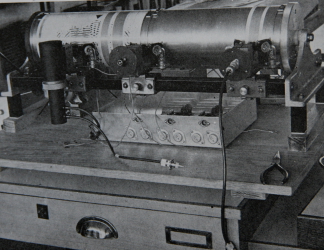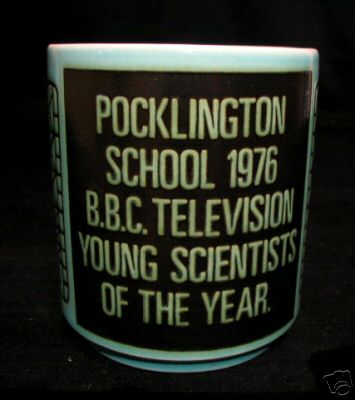This post is something of a reminisce for me – because – I was there; albeit as an attendee, not a competitor, at Leicester’s Gateway Grammar School. Although too young to participate, I saw the effect the show had on the school, its pupils, and the viewing public.
So, beyond the nostalgia, can we learn something from the Young Scientists phenomenon?

The show’s origins trace back to the formation in 1963 of the Science and Features Department of the BBC: the group that gave us Tomorrow’s World, the Royal Institution Christmas Lectures, and the iconic productions of Jonathan Miller, Jacob Bronowski and David Attenborough. The team also produced Heinz Wolff’s next project after Young Scientists – The Great Egg Race.
Production entailed a combination of material filmed at the participants’ schools, cut with Q&A sequences from the studio. During the judging, contestants sat nervously with their rigs as backdrop.
My school participated twice. A project on PVC reached but floundered in the final, while an invention that automatically scanned fingerprints won in the UK final and the competition’s European equivalent, hosted by Phillips in Eindhoven. The self-effacing commentary of the PVC team, reproduced from the School Magazine, reveals the production pressures, and gives an honest insight into how laboratory science really works when delivering breakthroughs to order.
” We had won the heat largely on the technical achievement of building the machine and so we made it our policy to concentrate on doing some research with it rather than make modifications to improve its working. With reactions taking up to eight hours and only a few weeks to go before the recording of the final, we had to start working late again and on occasions were still at school at about 2 a.m. During this time we managed to produce two polymers, B.S.R. and P.E.O. but with the limit on our time we were able to complete only a preliminary investigation into these polymers. From these results we managed to draw a few vague conclusions and plan our future research. Armed with this we went to Birmingham for the recording of the final. We were not so apprehensive about what would happen this time as we had the experience of our first visit behind us. As expected, the procedure was much the same as before and we approached the day for judging and filming in a much calmer state of mind than on the first occasion. However, as soon as the first judge, Sir George Porter, began to question us we began to realise that all was not going well. He continually probed us about details of the process which we had only just begun to study. Because of the short period of time which was available to us between heat and final we had not been able to familiarise ourselves with all aspects of the chemistry of the process. Consequently our answers to our questions were rather vague and lacking in the detail that he seemed to want.“

The series ran for nine years on BBC1. Why so successful? The popularity, I suggest, was partly due to the show’s tangible competitiveness – the ‘tune in again next week’ factor. The content itself was made accessible through the pupils’ explanations and chatty atmosphere of the studio. By raising the status of school science and ordinary pupils, there may even have been some flattery of parents by association.
Were there deeper benefits beyond entertainment value? Who knows how many fifteen year olds were swayed to science A-Levels by an inspiring episode of Young Scientists? I believe the participant schools were strengthened by the experience, and others motivated to reach the grade. Involvement would encourage higher quality teacher and pupil applicants to the school, and raise the school’s status with universities and employers. For those directly involved, the show was a springboard.
Could the formula be repeated? Was Young Scientists simply ‘of its time’ – never to be repeated? Promotion of school science is now more important than ever. Science competitions for young people still exist, but do they afford science the public exposure, status, and continuity offered by Young Scientists. Critics might say the format wreaked of elitism (the Grammar to Comprehensive school ratio would be interesting). Do schools have the time now? Would staff be motivated and willing? What about health and safety; PVC manufacture at 2 a.m.?
Despite the obstacles, the goal of broadcasting innovative school science – on prime time national television – with our greatest scientists in attendance – is a noble aspiration.
Could the UK public again be enticed to watch school kids do science? I like to think so.
